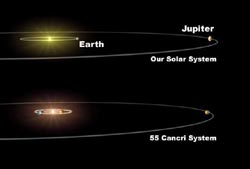This area deals with the fundamental laws and building blocks of nature and how they interact, the properties and the behavior of matter, and research into space and time and their structures.
innovations-report provides in-depth reports and articles on subjects such as astrophysics, laser technologies, nuclear, quantum, particle and solid-state physics, nanotechnologies, planetary research and findings (Mars, Venus) and developments related to the Hubble Telescope.

The Russian astrophysicists have theoretically modelled coronal loop oscillations and have shown that the plasma present in coronal loops is quite “normal”. So, the puzzle of the Sun`s atmosphere heating remains unresolved.
Coronal loops, immense magnetic arches more hot and dense than the coronal gas, are formed by magnetic fields. They are anchored in the Sun`s visible surface rising up to 100 – 200 thousand kilometres. In the active regions of the Sun these loops, which are 1000 –

Physicists have to tread carefully when it comes to fertiliser, but the first tentative steps to a better understanding of the ancient art of fertilising the soil are described in a paper published today in the Institute of Physics publication, The Journal of Measurement Science and Technology.
Frederic Cointault, Philippe Sarrazin and Michel Paindavoine of the University of Burgundy in Dijon, France show how to take a snapshot of particles of fertiliser as a centrifugal spreader spits them

A manikin called Walter that can be used to test new clothes for extreme environments is described in research published today in the Institute of Physics publication Journal Measurement Science and Technology. Jintu Fan and Yisong Chen of the Institute of Textiles and Clothing at Hong Kong Polytechnic University, in Kowloon, explain in the journal how Walter`s special skin can simulate perspiration while his motorised limbs can be moved to make the manikin walk, for a more realistic test.
C

The scientists from NPO Astrofizika, have designed a terrestrial telescope, which has no match all over the world. Fundamentally new technical solutions ensure that a unique telescope with the mirror of 25 meters in diameter is able to investigate previously invisible celestial objects of up to the 29-th magnitude.
What makes astronomers design the telescopes with the larger and larger mirrors? Certainly, astronomers are driven by the capacity of a telescope to provide more informati

A team of scientists from the U.S. Department of Energy’s Brookhaven National Laboratory, the U.S. Department of Commerce’s National Institute of Standards and Technology (NIST), and the University of Oslo in Norway has provided new insight into the superconductivity of magnesium diboride (MgB2), an unusual superconductor discovered only last year. The new result appears in the June 17, 2002 issue of Physical Review Letters.
Understanding the origin of superconductivity — the ability of som

After 15 years of observation and a lot of patience, the world’s premier planet-hunting team has found a planetary system that reminds them of our home solar system.
Geoffrey Marcy, astronomy professor at the University of California, Berkeley, and astronomer Paul Butler of the Carnegie Institution of Washington, D.C., today announced the discovery of a Jupiter-like planet orbiting a Sun-like star at nearly the same distance as the Jovian system orbits our sun.
“All other extr